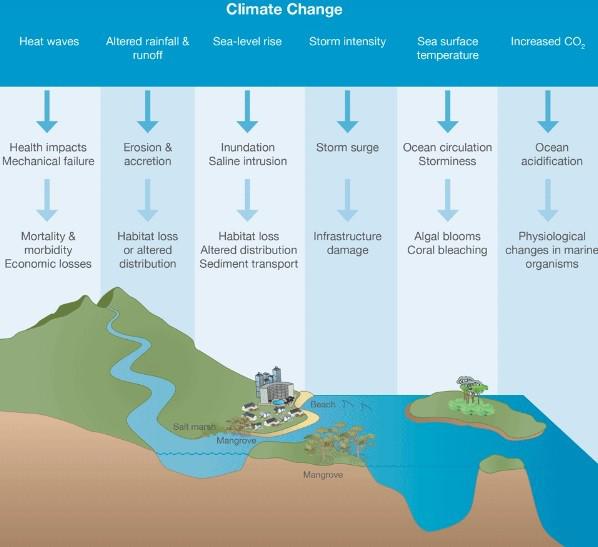Mains Daily Question
Feb. 15, 2023
Explain how climate change impacts coastal areas. Highlight some solutions to tackle the impact of climate change on coastal areas of the world. (10 Marks)
Answer.
Climate change refers to long-term shifts in the Earth's weather patterns, resulting in changes in temperature, precipitation, and other climatic factors. These changes are primarily driven by anthropogenic activities, such as burning fossil fuels, deforestation and overpopulation, which releases greenhouse gases into the atmosphere, which traps heat in the atmosphere, causing global warming.
Effects of climate change on coastal regions:
- Coastal areas will experience floods and erosion as a result of a rise in sea levels. For instance, according to the IPCC report, sea levels are expected to increase by 0.26 to 2.1 metres by 2100, potentially forcing millions of people to relocate. Kiribati will be the first country that will be swallowed completely due to climate
- Warmer ocean temperatures would probably cause storms and hurricanes to be stronger, which will cause more damage to coastal cities. As an illustration, research by NASA estimates that Hurricane Katrina in 2005 cost the Gulf Coast region approximately $160 billion in damages.
- Ocean acidification: Increasing atmospheric CO2 concentrations is making the oceans more acidic, which could harm marine life and deplete fish stocks, having a direct impact on coastal economies. One industry that has significantly lost money as a result of acidification is the clam industry in the Pacific Northwest.
- As sea level will rise, saltwater intrusion into freshwater aquifers is a possibility, which can contaminate soil and make drinking water scarce. For instance, as UNDP noted, portions of the Mekong Delta in Vietnam have recently been subject to saltwater intrusion.
- Heatwaves: Extreme temperatures and heat waves, which are made worse by climate change, can lead to heat exhaustion and heat stroke, especially in metropolitan coastal locations. As an illustration, 70,000 people died in the 2003 heatwave in Europe, many of whom were residents of coastal cities, as per WHO report.
- Degradation of coral reefs: Ocean acidification and rising ocean temperatures can damage and bleach coral, which has an impact on coastal economies and marine biodiversity. An extreme bleaching episode recently occurred on the Great Barrier Reef.
- Coastline erosion is a result of climate change and could endanger infrastructure and property values.
Thus, climate change has a major and wide range of effects on coastal regions, affecting not only the environment but also the economy and public health. To lessen these effects and safeguard coastal towns, we must take specific actions.
The following are some actions that can be taken to combat the effects of climate change on coastal areas:
- Land-use planning, the construction of sea walls, the restoration of mangroves, and other adaptation strategies should be used to prepare for sea level rise. In the Netherlands, dikes and other infrastructure have been used for a long time to manage coastal floods.
- Increasing the usage of renewable energy sources, such as wind and solar, will help to cut greenhouse gas emissions and slow down climate change. For instance, according to Energy Watch Group, in 2020 Denmark produced 47% of its electricity using wind power.
- Promote sustainable tourism that is environmentally responsible, benefits local communities economically, and safeguards coastal ecosystems. The Palau Pledge urges visitors to safeguard the natural resources of the island.
- Take action to minimise emissions by putting in place regulations like carbon pricing and gradually eliminating subsidies for fossil fuels. For instance, by 2030, the European Union promises to cut its emissions by at least 55%.
- Infrastructure that can resist extreme weather events should be constructed in a climate-resilient manner, including buildings, bridges, and roadways. For example, the Rebuild by Design project in the United States creates robust infrastructure to safeguard coastal communities from upcoming hurricanes.
- Research and monitoring: Need of the hour will be to develop more research and development, followed by proper monitoring to keep track of climate change on a regional as well as global scale. The Global Ocean Observing System keeps tabs on the state of the oceans and the effects of climate change.
Overall, there is a need for holistic efforts toward public education, awareness of all stakeholders about such impacts, and the mitigating steps to be taken. One such example is instruction and training on climate change issues provided by the Climate Reality Project. We should move towards consensus building through such awareness to ensure the realisation of a resilient future.


